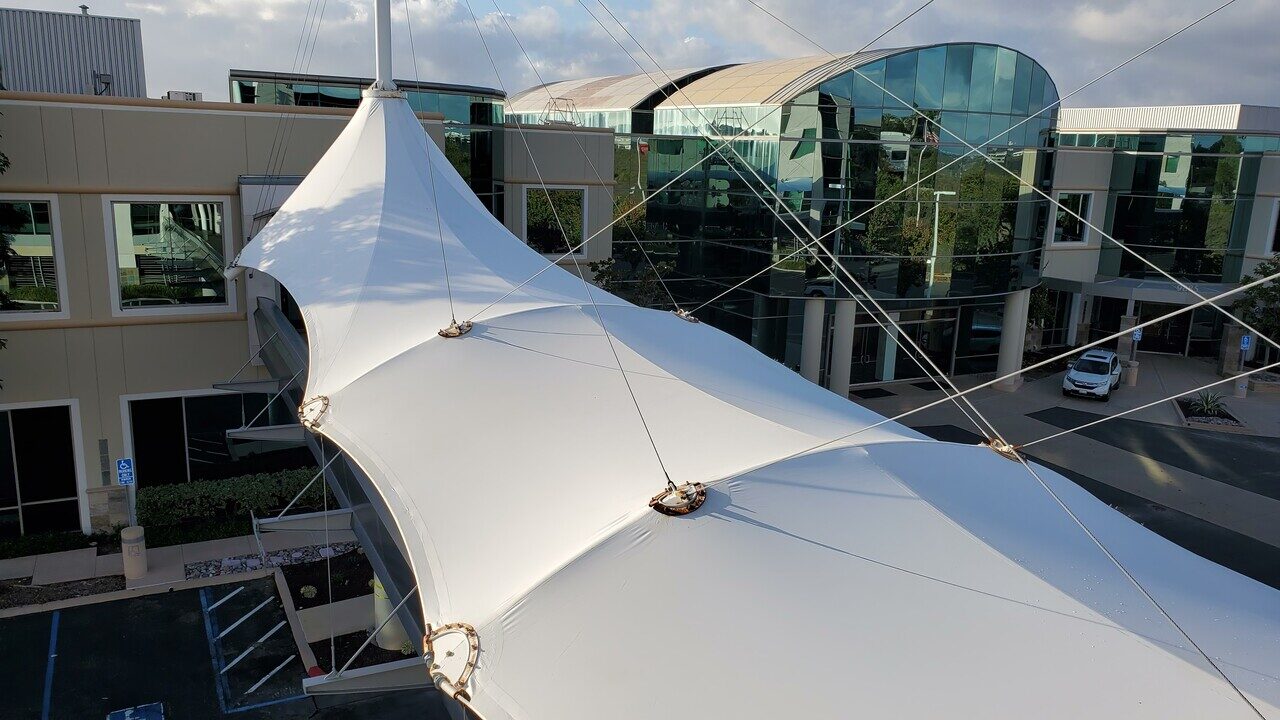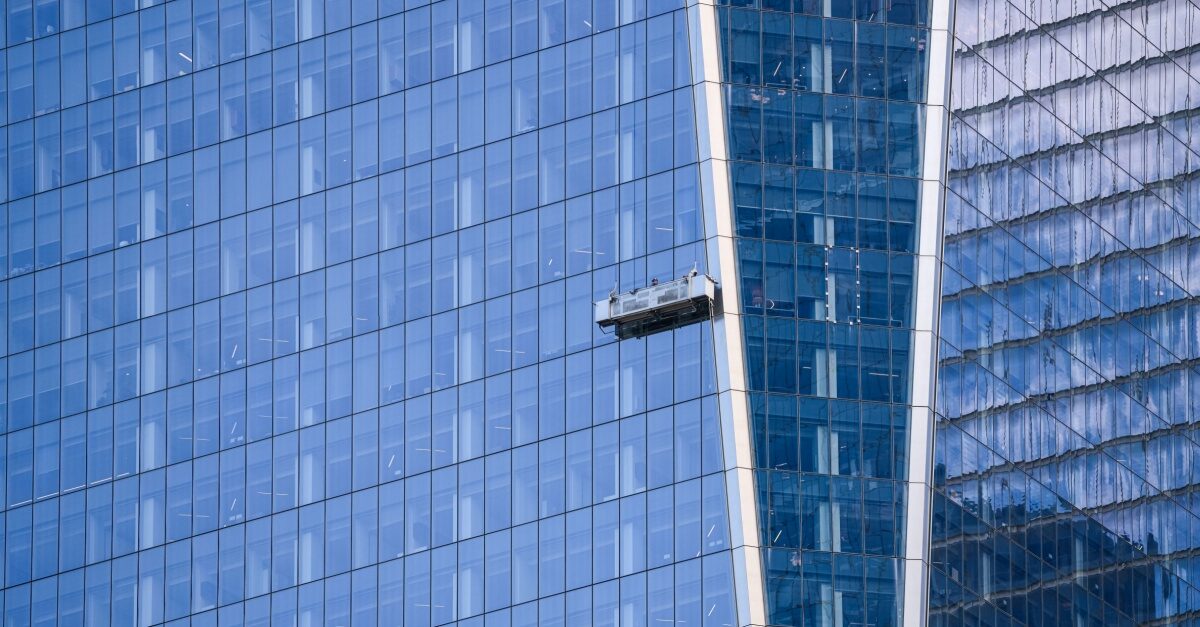Canopy & Awning Cleaning: Expert Answers to FAQs
Canopies and awnings may take up a small share of your maintenance budget, but they make a big impact. Neglecting them accelerates deterioration and leads to premature replacement. When fabric structures accumulate grime and mildew, tenants notice, and their service life is shortened.
The challenge most property teams face isn’t recognizing the problem, it’s knowing what actually works. How often do you really need to clean? Which chemicals won’t void warranties or damage materials? Does sealing justify the cost? When does it make sense to handle cleaning in-house versus bringing in a contractor?
Below, we answer five frequently asked questions by property managers and building engineers regarding canopy and awning cleaning. We offer specific guidance on frequency by environment, material-safe chemistry, sealing schedules, vendor selection criteria, and how to structure a maintenance program that protects both appearance and budget.
How Often Should Canopy and Awning Cleaning Happen?
Plan canopy and awning cleaning three to four times per year to protect appearance and extend fabric life without overinvesting in labor. However, that’s just a baseline. Where your schedule needs adjustment depends on what your canopies face daily.
For properties near highways, airports, or kitchen exhaust that accumulate airborne pollutants faster, we recommend a monthly clean to keep ahead of grime. Heavy tree cover exacerbates the problem in different ways, adding organic debris and creating conditions that favor the growth of mildew. Coastal and humid climates (i.e., Florida) compound both issues through constant moisture, insect activity, and intense UV exposure.
Factory clear coats like 3M or Tedlar help, but they slow down the buildup rather than prevent it. The fabric still requires consistent attention.
Set your cadence based on these exposures, then review conditions quarterly to determine if you need to increase frequencies. Catching deterioration early prevents visible damage and the replacement costs that follow.
Which Cleaning Chemicals and Methods Are Safest?
Catching problems early through regular cleaning only works if you use the correct cleaning methods and solutions.
Material identification comes first. Canopy and awning material and weight determine which products work without causing damage. Contact the manufacturer when possible to confirm specifications.
A handful of established product lines exist specifically for cleaning and sealing awnings and canopies. Our experts can determine the best cleaning solution and sealer for your canopy and awnings, depending on the material (acrylic, polyester, vinyl, etc.) and condition.
How you clean also matters as much as what you use. Professional awning cleaning addresses both exterior and underside, uses low-pressure rinsing instead of pressure washing, and protects lighting, speakers, and electrical components underneath.
Make sure you keep your vendors accountable. Require them to document material identification, provide chemical lists with Safety Data Sheets, specify sealer type by material, confirm rinse method, and outline underside protection.
Do We Really Need to Seal — and How Often?
Yes. Sealing extends fabric life and prevents the damage that leads to premature replacement.
The frequency depends on the material and treatments, such as whether it is printed or blank. We always recommend sticking to the awning and canopy manufacturer’s recommendations.
Properties that maintain sealing schedules experience measurable benefits, including stronger UV resistance, better protection against stains and mildew, and preserved color across the portfolio. Properties that skip sealing face faded, deteriorating canopies within months, regardless of cleaning frequency.
Most important is the cost difference. Sealing after canopy and awning cleaning adds minimal expense compared to replacing damaged fabric years ahead of schedule. It also has a positive effect on your property’s curb appeal.
When Should We Call a Professional vs. Handle In-House?
Knowing the proper procedures is important, but so is knowing when to bring in the experts. Working at heights and around specialized materials comes with serious safety considerations, so professional canopy and awning cleaning services should be called when:
- Safety is a concern. Anytime work requires ladders, lifts, or access at height, trained technicians with proper fall protection equipment should take the lead.
- You’re managing mixed materials or coatings. Different fabrics, sealants, and metals need specific cleaning solutions and methods to prevent costly damage.
- There are electrical components underneath. Lighting, speakers, or wiring must be shielded from moisture and treated with low-pressure cleaning techniques.
- Minor maintenance is needed. Professionals can safely perform small patches or surface repairs on backlit or tensioned units.
- Major repairs arise. The manufacturer or a qualified vendor should always handle structural rework, fabric replacement, or electrical fixture servicing.
When in doubt, call an expert. Our trained professionals have the right equipment, knowledge, and safety protocols to keep your canopy and awning systems performing.
How Do We Build a Smart Maintenance Plan and Budget?
A well-structured maintenance plan protects your investment, your tenants, and your team. We recommend starting with quarterly canopy and awning cleaning as a baseline. Properties located near pollution sources, grease exhaust, or heavy tree cover may require bimonthly or even monthly service to prevent buildup and staining.
Always apply sealers according to manufacturer guidelines, as this can directly affect warranty coverage and long-term performance.
Centralize key details for each property, including material identification, service history, and asset condition, to ensure consistent care across your portfolio. Standardize scopes of work by material type, defining cleaning products and sealing specifications, and include post-storm or seasonal inspections in regions with high pollen or weather exposure.
Tracking performance is just as important. Measure your program’s success through avoided replacements, reduced repair costs, and extended fabric life. Properties that maintain consistent schedules typically preserve aesthetics and defer capital expenses far longer than those that clean reactively.
And you don’t have to figure it out alone. We can help you design a comprehensive canopy and awning maintenance program tailored to your specific materials, safety requirements, and budget. Our team will work with you to develop schedules, document specifications, and ensure that every aspect of your program meets manufacturer and safety standards.
Stop Replacing What You Could Be Maintaining
Canopy and awning care isn’t just about keeping things clean; it’s about extending the life of valuable assets and maintaining a safe, professional environment. The difference between reactive cleaning and proactive maintenance is years of service life and thousands in avoided costs.
Our teams don’t just wash fabric—we build comprehensive maintenance programs tailored to your portfolio, safety needs, and budget. From safe access at height to the right cleaning solutions and sealants, our teams handle every detail so you don’t have to.


